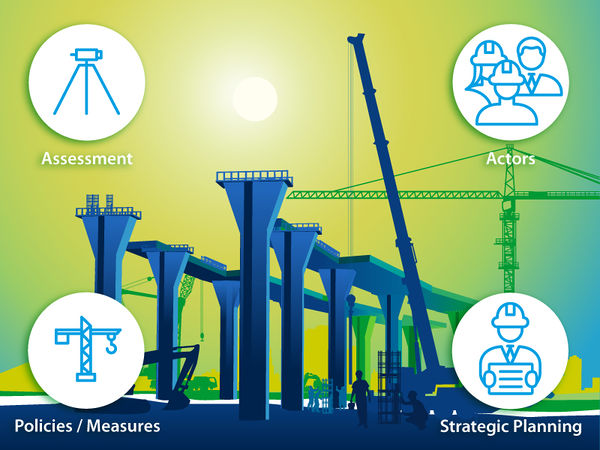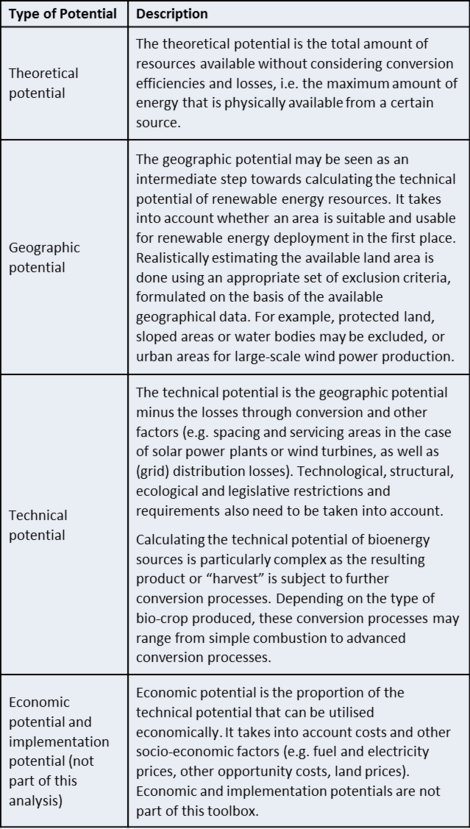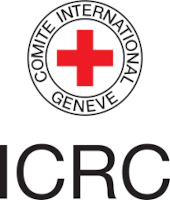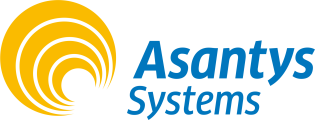Difference between revisions of "SE4Jobs Toolbox - Assessment"
From energypedia
***** (***** | *****) |
***** (***** | *****) |
||
| Line 77: | Line 77: | ||
In addition to existing capacities at national or subnational level, there are many regional and international organisations that gather and share data on RE and EE, serving as a further source of information and orientation. Such sources include the annual REN21 Global Status reports, IRENA’s RE data publications<ref>See http://resourceirena.irena.org/gateway/dashboard/</ref> and its regular RE Jobs reports, the FS-UNEP reports on Global Trends in Renewable Energy Investment, as well as the IEA’s Energy Efficiency Market reports and the World Energy Council’s databank on energy efficiency indicators<ref>See https://www.wec-indicators.enerdata.eu/ </ref>. Other sources provide guidance and methodologies for conducting assessments (e.g. the International Labour Organisation’s publications on assessing the employment effects of RE/EE). | In addition to existing capacities at national or subnational level, there are many regional and international organisations that gather and share data on RE and EE, serving as a further source of information and orientation. Such sources include the annual REN21 Global Status reports, IRENA’s RE data publications<ref>See http://resourceirena.irena.org/gateway/dashboard/</ref> and its regular RE Jobs reports, the FS-UNEP reports on Global Trends in Renewable Energy Investment, as well as the IEA’s Energy Efficiency Market reports and the World Energy Council’s databank on energy efficiency indicators<ref>See https://www.wec-indicators.enerdata.eu/ </ref>. Other sources provide guidance and methodologies for conducting assessments (e.g. the International Labour Organisation’s publications on assessing the employment effects of RE/EE). | ||
| − | A starting point could be to commission a comprehensive study on the potentials for RE and EE in your country, addressing the above-mentioned questions. As a next step, units in scientific agencies such as environmental agencies may build up capacities for data collection and evaluation, including economic modelling and scenario building. A key requirement for this is the availability of | + | A starting point could be to commission a comprehensive study on the potentials for RE and EE in your country, addressing the above-mentioned questions. As a next step, units in scientific agencies such as environmental agencies may build up capacities for data collection and evaluation, including economic modelling and scenario building. A key requirement for this is the availability of economic input-output tables (I/O tables). In their standard form, I/O tables reveal the sources of value creation throughout the value chain. The data can be enriched by employment figures and, from the point of view of developing a green economy, with data on emissions and resource use (physical I/O table). This allows the analysis of the jobs created along the value chain with respect to emissions and resource use. National statistical offices should provide such I/O tables and update them on a regular basis. |
</div> | </div> | ||
=== Practical aspects of the issue and good practice examples <span style="line-height: 21px"><span class="mw-customtoggle-title5" style="font-size:small; font-weight: bold; display:inline-block; float:center; color: blue"><span class="mw-customtoggletext">'''[Expand]'''</span></span></span><br/> === | === Practical aspects of the issue and good practice examples <span style="line-height: 21px"><span class="mw-customtoggle-title5" style="font-size:small; font-weight: bold; display:inline-block; float:center; color: blue"><span class="mw-customtoggletext">'''[Expand]'''</span></span></span><br/> === | ||
| Line 87: | Line 87: | ||
Assessing the natural conditions for harvesting sun, wind, hydro, bio and geothermal energy in your country is an important first step in analysing and comparing the potential that different RE sources have for energy generation (and therefore job creation). | Assessing the natural conditions for harvesting sun, wind, hydro, bio and geothermal energy in your country is an important first step in analysing and comparing the potential that different RE sources have for energy generation (and therefore job creation). | ||
| − | Many different types of sources are available for estimating the occurrence and distribution of RE in a country. These range from academic papers, to government reports, to publications by international organisations. For example, the South African National Energy Development Institute, Mexico’s Energy Ministry and India’s Ministry of New and Renewable Energy all regularly issue high-quality data on their respective RE potentials | + | Many different types of sources are available for estimating the occurrence and distribution of RE in a country. These range from academic papers, to government reports, to publications by international organisations. For example, the South African National Energy Development Institute, Mexico’s Energy Ministry and India’s Ministry of New and Renewable Energy all regularly issue high-quality data on their respective RE potentials<ref>See joint SENER-IRENA report "Renewable Energy Prospects: Mexico" (2015): http://www.irena.org/DocumentDownloads/Publications/IRENA_REmap_Mexico_report_2015.pdf; and Wind Atlas of South Africa: http://www.wasaproject.info/index.html</ref>. Beyond these self-assessments, there are also a number of international agencies that produce quality data. For instance, IRENA has developed the Global Atlas for Renewable Energy platform<ref>The Global Atlas for Renewable Energy is available at http://irena.masdar.ac.ae/ </ref>, which integrates a large amount of assessment data for multiple RE technologies on a global scale. |
To correctly assess a country’s RE potential and precisely define its expected contribution, it is important to distinguish between different kinds of potentials. The table below provides a brief overview. | To correctly assess a country’s RE potential and precisely define its expected contribution, it is important to distinguish between different kinds of potentials. The table below provides a brief overview. | ||
| − | ''' | + | '''Table: Different types of renewable energy potentials<ref>See IRENA, 2014, p. 9</ref>''' |
| + | |||
| + | '''[[File:RE Potentials.png|center|470pxpx]]''' | ||
'''Assessing the employment potential in RE/EE markets''' | '''Assessing the employment potential in RE/EE markets''' | ||
Revision as of 13:02, 22 November 2017
SE4Jobs Toolbox – Laying the foundations for a sustainable development

Tools
PRODUSE EQuIP CADRE Interactive AILEG HELIO ELMA |
What is the issue assessment of existing capacities and potentials about? [Expand]
Why is such an assessment important for the expansion of RE and EE? [Expand]
What are key questions for addressing the issue of assessing existing capacities and potentials? [Expand]
How can the issue of assessing existing capacities and potentials be addressed? [Expand]
Practical aspects of the issue and good practice examples [Expand]
Challenges in implementing the issue of assessing existing capacities and potentials [Expand]
|
Good Practices
Brazil China India Mexico South Africa Turkey |
Reference
- ↑ IRENA, 2015c, provides a thorough overview on the methodology used in the assessment of employment effects of RE.
- ↑ See http://resourceirena.irena.org/gateway/dashboard/
- ↑ See https://www.wec-indicators.enerdata.eu/
- ↑ See joint SENER-IRENA report "Renewable Energy Prospects: Mexico" (2015): http://www.irena.org/DocumentDownloads/Publications/IRENA_REmap_Mexico_report_2015.pdf; and Wind Atlas of South Africa: http://www.wasaproject.info/index.html
- ↑ The Global Atlas for Renewable Energy is available at http://irena.masdar.ac.ae/
- ↑ See IRENA, 2014, p. 9
- ↑ To distinguish the two concepts of direct and indirect employment: “direct employment effects refer exclusively to effects that are brought about directly by the measure concerned, or in a selected sector (e.g. renewable energies). Indirect employment effects are those that are brought about in the upstream or downstream stages of the value chain” (Jacob, Quitzow & Bär, 2015, p. 11).
- ↑ There are, for example, considerable disparities in the number of person-years of employment in solar PV, depending on whether it is large-scale, ground-mounted PV or distributed rooftop PV.
- ↑ “O&M” stands for the operation and maintenance of RE technologies.
|
This article is part of the RE-ACTIVATE project. RE-ACTIVATE “Promoting Employment through Renewable Energy and Energy Efficiency in the MENA Region” is implemented by the Deutsche Gesellschaft für Internationale Zusammenarbeit (GIZ) GmbH on behalf of the German Ministry for Economic Cooperation and Development (BMZ). |





















